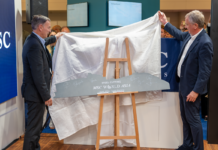
Silversea’s new ship Silver Moon is one step closer to welcoming the cruise line’s guests, having successfully carried out her sea trials between 8th August and 20th August. Carrying a reduced crew of approximately 320 due to precautionary health protocols, the ship journeyed between Fincantieri’s shipyards in Ancona and Trieste, Italy, undergoing a week-long dry-dock period in the latter. With a delivery date set for 30th October, Silver Moon will become the second ship to join Silversea’s ultra-luxury fleet in 2020, following the delivery of Silver Origin on 3rd June.
THE SEA TRIALS
Silversea’s senior officers, external engineers, and representatives from both Fincantieri and the Royal Caribbean Group put Silver Moon through a series of preliminary tests in the Adriatic Sea – including noise, and vibration tests – for three days from 8th August. Once Silver Moon was out of the water in Trieste, stability tests were performed; public spaces were inspected; and engineers applied the finishing touches to the ship’s exterior, including the cleaning and painting of the hull, and the polishing of the ship’s brass propellers. Secondary tests, including speed tests, were then carried out on the return sailing from Trieste to Ancona. Work has now recommenced on the ship’s interior, ahead of the vessel’s official delivery in October.
SILVER MOON’S BUILD IN NUMBERS
The sister ship of Silversea’s Silver Muse, Silver Moon represents the latest accomplishment in the cruise line’s long-standing partnership with the illustrious shipbuilder Fincantieri. During the peak months of Silver Moon’s construction in Ancona, over 1,000 skilled professionals were working on the ship simultaneously, with over 390 companies contributing to the build. Painted using almost 100,000L of paint, over 15,000 steel plates and profiles were cut to form the ship’s superstructure – 920t of which were transported from 755nm away. Approximately 1,690,000m of electric cable were installed by 18 contractors, as well as 60,000m2 of insulation, 450,000kg of air conditioning ducts, and 92,000kg of ventilation ducts. Moreover, over 5,000 automation channels have been installed to link the ship’s mechanisms.




